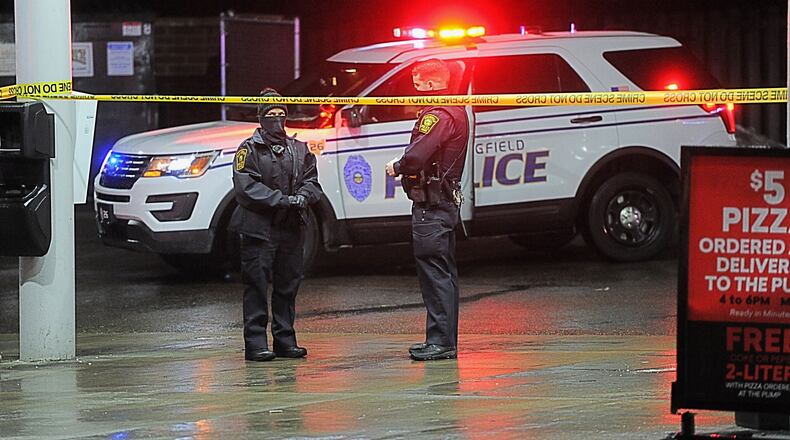Springfield officials hope to be awarded money from the state as part of a program that aims to provide police departments that do not have body cameras with much needed funding to make those purchases.
The city applied for the Ohio Body-Worn Camera Grant through the Ohio Office of Criminal Justice this week for an amount of up to $383,194. If that request is met it will allow for the purchasing of the cameras as well as help cover the initial costs of implementing them into the service of the Springfield Police Division.
Springfield police officers do not have or wear body cameras as officials have cited the high costs of acquiring that equipment. However, officials have expressed interest in implementing body cameras for a number of years.
Those that have called for the implementation of body cameras say it helps increase transparency as well as can play a part in building up community trust.
Body cameras have also been part of the national discussion on policing in the country following widespread social justice protest last year that called out police brutality and lack of transparency.
“At any interval, anytime that any police department can enhance their tools, It is good for everyone. It increases accountability and transparency on both sides,” said James Bacon, the Chairperson of the Community Police Advisory Team, which works to strengthen relationships between Springfield officers and the community they serve.
The organization that Bacon is a part of had identified body cameras as an important tool for Springfield officers. However, the police division had been working on ways of acquiring that equipment before the official formation of the team this year.
“We came in at the right time with (body cameras) already being in discussion and being on the table. We were just encouragers of pushing forward and getting it done,” Bacon said.
Denise Williams, the president of the Springfield unit of the NAACP, said that body cameras are needed in the city as they can help clarify situations and prevent misunderstandings or speculation surrounding certain cases.
Williams said that body cameras could have provided more clarity around the case of Eric Cole, a shooting victim who was run over by a Springfield police officer responding to the scene in her cruiser in June.
The police officer was responding to reports of a shooting.
Credit: Bill Lackey
Credit: Bill Lackey
The incident was caught on cruiser camera, but Williams said that body camera footage could have helped clarified what happened after the officer left their cruiser following the incident.
Williams said that body camera footage would have shown the officer’s actions after they left the car, what was done and said and what procedures were followed or not followed at the scene.
Williams said that footage would have provided a recording that could reassure that proper procedures where followed or showed if there was misconduct. She added that can be applied to any case.
The investigation of the incident is being handled by the state, which is customary in situations involving Springfield officers, and the officer involved in the incident Amanda Rosales is on administrative leave.
Springfield Police Chief Lee Graf said that the division has been in favor of acquiring body cameras for personnel for sometime. But he said that concerns regarding costs and finances have been the biggest barrier.
That was something that Bacon also noted.
“ It never had been an issue that the police division did not want them. It was centered around a lack of funding,” Bacon said.
“This is something that came about at a much higher level at the state. It is very helpful for not just Springfield but every community that at this point still do not have body cameras,” Bacon said of the grant that would allow for Springfield to implement those cameras.
Graf noted that grant opportunities in the past had been limited in terms of what that money could be spent on and in some cases wasn’t enough to cover the costs of implementation.
But what is now being offered by the state allows more flexibility in terms of covering those costs.
The grant that the city has applied for is part of a program that has allocated $5 million in funding to help local law enforcement agencies invest in body camera equipment and pay for associated expenses.
Graf said now they are looking at cameras that would be compatible with those already located in police cruisers as well as the computer system used by the division.
Graf said that implementing body cameras in the division is a big financial commitment for the city. He added that costs aren’t just related to the buying and implementation of the cameras, but maintaining them as well as complying with public record requests and making sure that released footage is protecting private information that can be compromised.
The planned implementation of body cameras may also result in a person being hired to maintain that footage as well as making sure footage that is being sent out is being edited to protect certain personal information.
That could be blurring or bleeping out social security numbers or blurring the faces of juveniles, Graf said, who also noted that the majority of requested footage will be used in courts.
He said the benefit of the cameras does not just relate to calls for transparency or tools to document police misconduct, but it also serves as strong evidence in court related to criminal matters.
That footage could be used to provide context and evidence during cases related to crime. It can also be used to clarify situations and showcase actions taken by officers on the scene.
Graf said that it will provide a lot of evidence to prosecutors, especially in cases that do not involve accusations of police misconduct, and noted that is a big benefit to having body cameras.
He also noted that body cameras can help clear up some misconceptions that community members may have that is related to local policing.
Graf said though someone will likely have to be hired to manage and edit that footage, it doesn’t mean they would be omitting or altering it to exclude interactions involving officers who are on the street or responding to calls.
With the renewal this year of an income tax levy and the possibility of using state funds, the city has been able to move forward with its plans of implementing body cameras, said Graf.
That includes having a policy in place for when the funding goes through and the police division is able to get the cameras. Graf said that there are a number of police departments in the state and across the country that do not have body cameras.
Police departments that receive the state money will have to comply with body camera standards that are put forward by the Ohio Collaborative, which consists of law enforcement experts and community leaders from throughout the state to established standards when it comes to policing.
That includes what can and cannot be filmed or when officers would be required to have cameras. Those standards would serve as a base model and policy would also be formulated to take a number of different situations into account.
Graf said they are budgeting to have a camera for every person in the division, which at full staff is 130. However, that does not mean every officer in the division will be wearing a camera all the time, the police chief added.
Graf said uniform patrol would be wearing cameras as well as supervisors who will be working the street. That also includes those answering 911 calls. But he said they are working out the subtle details such as when detectives would be required to wear the cameras and how that would work.
Graf said the division has 88 officers that would fall under uniform patrol.
“Me as a chief of police, I probably normally would not have one. But there might be circumstances where I would,” Graf said, noting they are still going over policy as well as how those cameras would be implemented.
Credit: Bill Lackey
Credit: Bill Lackey
Graf said that they don’t want the cameras to be an impediment in certain situations such as when an officer or detective talks to a confidential informant.
“Will they be willing to talk to you if they are on camera as that video may be able to be acquired through legal means,” he said.
Graf said that is an example of the different situations they are taking into account as they formalize their body camera policy.
The idea is, if everything goes according to plan, is to have those cameras in use by the police division by next year.
By the numbers:
130 - Number of body cameras that will be budgeted for the Springfield Police Division
$383,194 - Amount that the city has applied for in terms of the Ohio Body-Worn Camera Grant
$5 million - Amount the state has allocated to help police departments that don’t have body cameras get that equipment
About the Author




